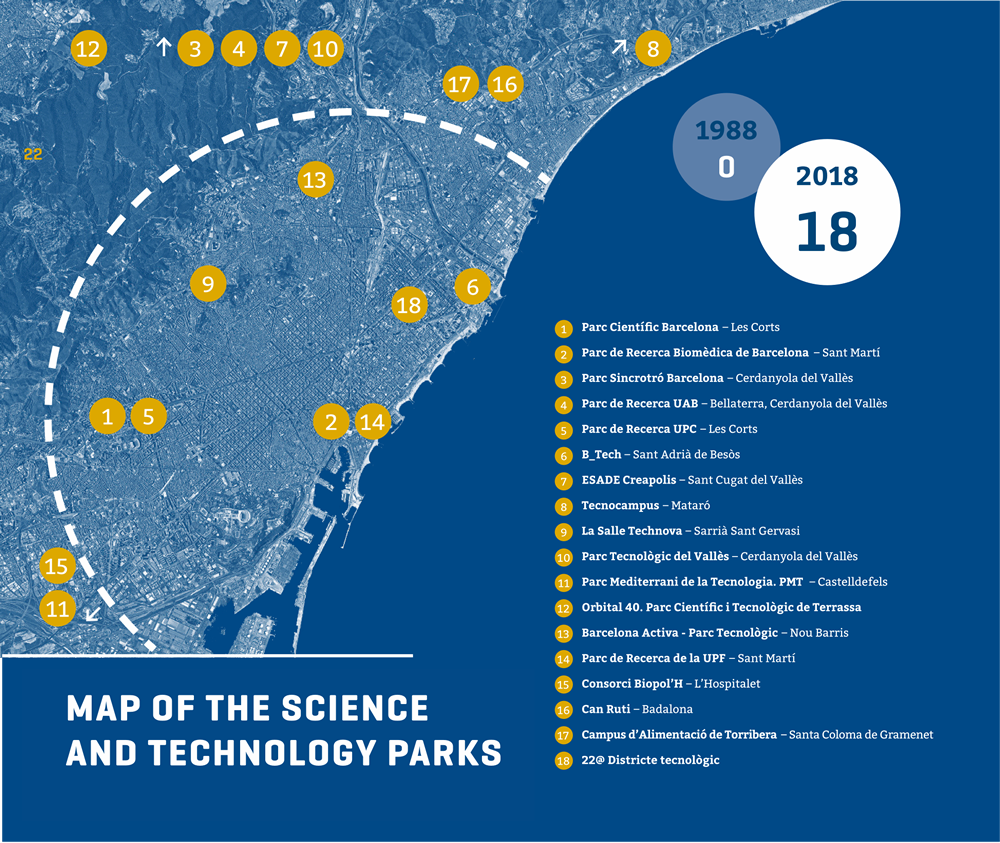Science parks and cities
For the 30th anniversary of the PEMB, we wanted to acknowledge one of the factors that has most influenced the development of the city during this period: scientific and technological research.
According to the Knowledge City Index, Barcelona is the fifth greatest city in Europe and the 17th worldwide in scientific and technological research. Moreover, it has achieved these positions in less than 30 years. The Barcelona Metropolitan Area currently has around 20 science and technology parks, most of which are not even 15 years old but have already significantly helped the development of the metropolis and have made Catalonia a European and international benchmark in the subject. In the current economic context, research, science and technological and social innovation are key to our future economic development. It is therefore essential to explain its origin and background, which is also achieved through contact with the people.


Maria Terrades
CEO of Barcelona Cientific Park
PAST
Catalonia's science parks were first created about 20 years ago, when, along with many other initiatives, the decision was made to position Catalonia as a leading region in life sciences, and particularly biotechnology.
Catalonia, and specifically Barcelona and its metropolitan area, already had the essential ingredients to create this leading cluster at the time, based on top universities in life sciences education and research, university hospitals and a large local pharmaceutical business network. From this foundation, other initiatives are being launched to position the region, including:
- The creation of research centres to promote the production, competitiveness and quality of the research done in Catalonia.
- The creation of the organisation ICREA to capture international talent and attract it to Catalonia, but also to bring back local talent that has gone abroad to pursue a scientific career in other countries.
- The creation of the agency AGAUR to manage research grants.
- And finally, the creation of science parks linked to universities, an infrastructure-based initiative. For life sciences, we have the Barcelona Science Park at the University of Barcelona, the Barcelona Biomedical Research Park at Pompeu Fabra University and the UAB Research Park at the Universitat Autònoma de Barcelona. In total there are about 16 science and technology parks in Catalonia, each specialised in a specific sector.
This specialisation allows each park to focus its investments and efforts to equip itself with scientific or technological infrastructure of a very specific sector, from which the whole surrounding community can benefit.
I have spoken about the past or beginnings of parks in Barcelona in a very simple way, but how do we see the parks today?
We understand science parks as ecosystems, clusters or hubs that combine science, technology, innovation, entrepreneurship and the business world to become a system producing both knowledge and business.
The Barcelona Science Park is an ecosystem focused on life sciences aimed at producing knowledge that can improve people's quality of life and standard of living. We work in fields of strategic knowledge such as biotechnology, bioinformatics, biomaterials, drug and medical device development, nutrition and cosmetics in a long list of therapeutic indications. This ecosystem currently has 100 organisations and over 2,700 professionals, from people with PhDs, postdocs or leading researchers at research centres such as IRB, IBEC and CNAG, to entrepreneurs who have created their own start-ups. And it also creates an ecosystem of highly specialised service providers, professionals dedicated to boosting technology transfer from universities to the private sector, such as Biocat, the Bosch i Gimpera Foundation, and large companies in the sector that focus their R&D&I in the Park, such as Esteve, Ordesa, Enantia and Qiagen.
What do we bring to the city? It is estimated that each worker employed in “innovative” organisations like those in the Park generate five additional jobs in their local service sector, in contrast to traditional manufactures, where the multiplier effect is less than two. These five new local jobs have a direct impact on Barcelona by creating jobs such as waitstaff, merchants and drivers, as well as other more qualified professions like doctors, teachers and lawyers. The impact that the creation of “innovative” jobs has on the city is therefore obvious.
It is also important to keep in mind that there is a relatively high proportion of women holding jobs in “innovative” health sector organisations. Specifically, 54% of the 2,700 people at the science park are women and 46% are men, and these figures have held stable over the past 10 years. Therefore, the park contributes to the city the growth of a sector in which women enjoy great visibility. However, when we analyse the proportion of women in positions with more responsibility (leading groups, entrepreneurs and directors), parity is lost and there are still more men in high positions. Therefore, we believe that the employment data for women are generally enviable compared to other sectors, but women must still be promoted to positions of responsibility.
We also understand that the creation of hubs based on innovation can have some negative effects on the city, such as rising costs of living, including housing and gentrification, but we understand that we must join the appropriate bodies in the city in working to alleviate these possible effects.
What does Barcelona bring to the innovation hubs? Talent. Thanks to its brand and quality of life, the city of Barcelona is an asset that we sometimes forget about when we are on the inside. From the point of view of someone living outside Catalonia and deciding where to build their life, Barcelona has incomparable appeal above many cities around the world in terms of opportunities for pursuing a career, leisure, culture, mobility, integration and tolerance. Another important point is transport. The Barcelona Science Park is located inside the city, which greatly facilitates the daily commute of the 2,700 professionals working there. Being well connected is essential for an ecosystem to grow and in fact, when we receive international delegations that come to visit the Park as a model, we recommend that they pay close attention to the subject of mobility.
In conclusion, a science park is a complex physical cluster that generates a critical mass of talent, knowledge and infrastructure that goes on to attract even more companies, more organisations and more talent in a kind of virtuous loop. Once a cluster is created and consolidated in a city, it is very difficult to relocate it. As such, it is a durable asset of high added value. Yet it is not static and must continue adapting to innovation, so it also needs institutional support.
And how do we see the future of these parks and cities?
There are things that we believe should not change. In particular, the purpose of the Barcelona Science Park was to bring the academic and business worlds together in the same physical space, sharing buildings, sharing scientific equipment, sharing scientists and researchers between research centres, universities and private companies and thereby promoting mobility between the research system and the productive, private sector. This premise, which was there at its inception, remains essential today.
Looking ahead, we also understand that if Barcelona and its area of influence are to continue competing worldwide in attracting and generating wealth, in a world that will talk increasingly of cities and less of regions, it is imperative that we support science, technology and innovation by supporting hubs.
It is well known that there are two prominent major strategic sectors in the Barcelona area: one is the ICT sector and the other is healthcare. As I have said, in Barcelona we have leading universities in the life sciences, university hospitals, CERCA research centres, major science infrastructure like science parks, the Barcelona Supercomputing Centre and the Alba Synchrotron, as well as large and small pharmaceutical and biotech companies that are a city's essential ingredients for generating knowledge and transforming it into wealth.
Therefore, we firmly believe that there must be institutional support for physical sector-focused clusters with unique infrastructure, as they are key to boosting cities, their wealth and their inhabitants' quality of life through the growth of a sector.

